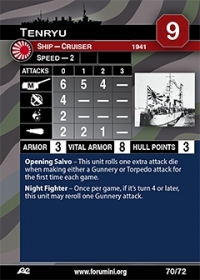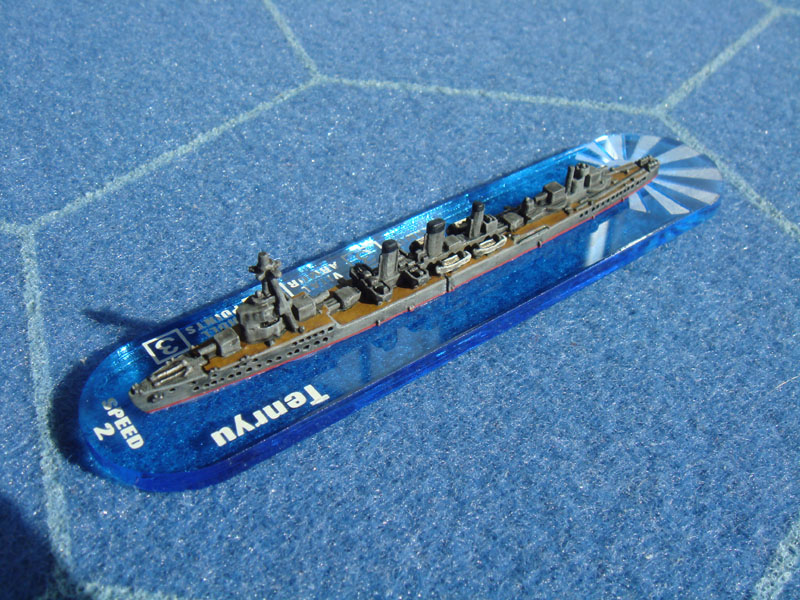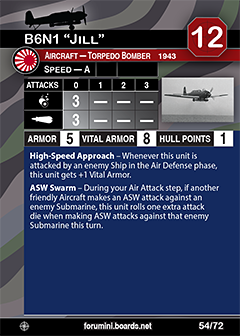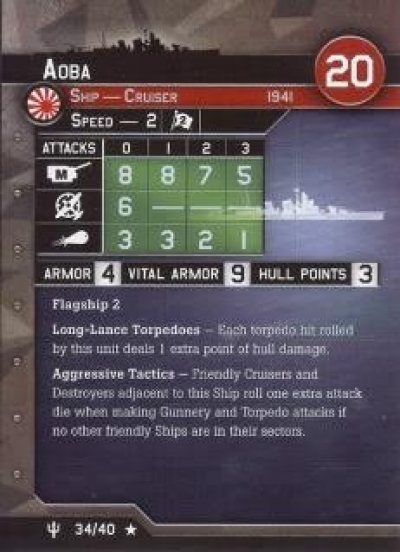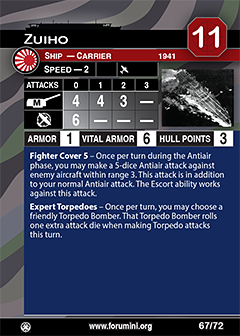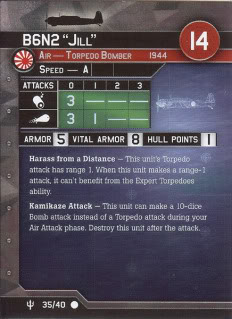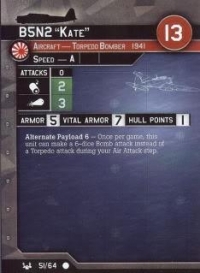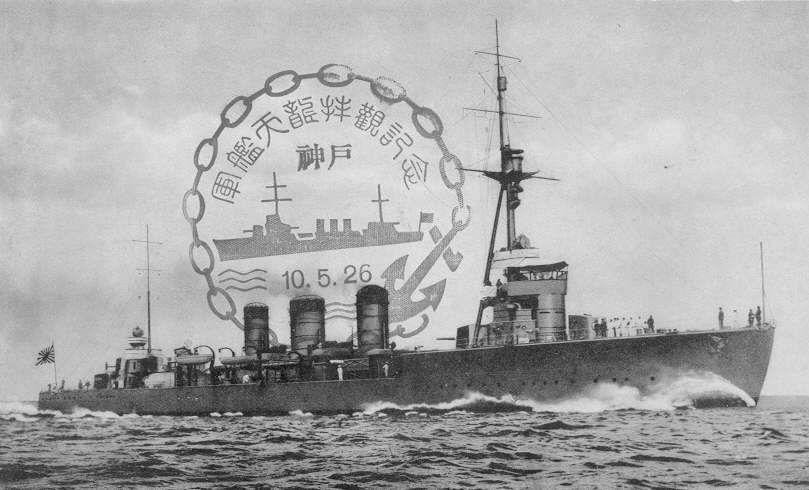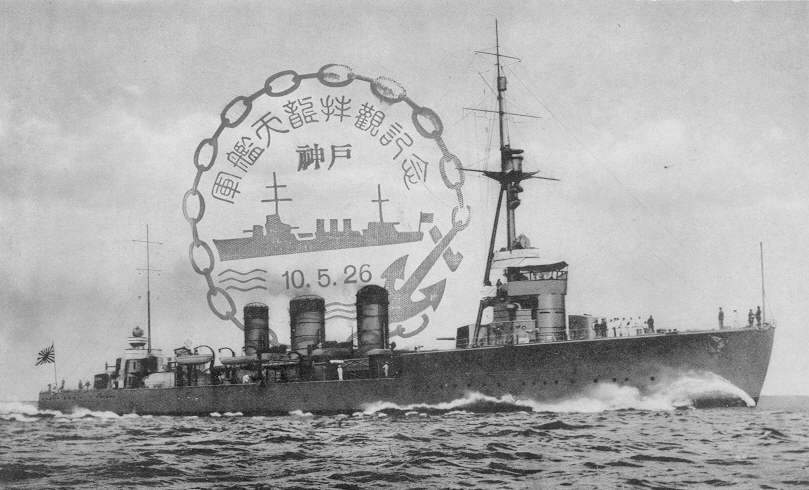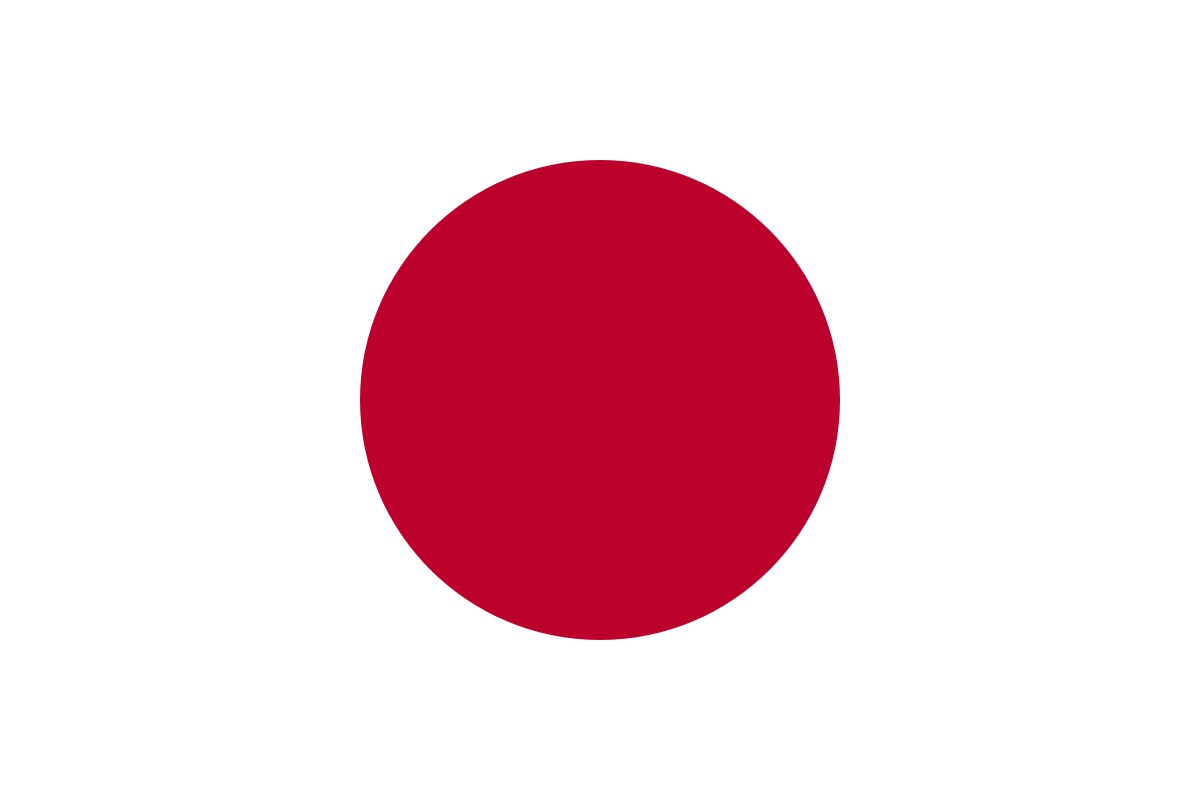Prototype: Tenryū was laid down on 7 May 1917 and completed on 20 November 1919, at the Yokosuka Naval Arsenal. Prior to World War II, she participated in the Siberian Intervention, Yangtze River patrols and supported the landings of Japanese troops along the China coast. During the early stages of the Pacific War, she participated in the Battle of Wake Island and the invasions of the Solomon Islands, New Guinea, Tulagi, and the Battle of Savo Island. Two of her torpedoes are credited with sinking USS Quincy (CA-39). She was sunk after the Naval Battle of Guadalcanal by USS Albacore, and struck on 20 January 1943.[4]
Class History: The two Tenryū-class cruisers were the first light cruisers operated by the Imperial Japanese Navy. They participated in numerous actions during World War II.
The Tenryū class was designed to act as flagships for destroyer flotillas. The design represented an intermediate class between the light cruiser and the destroyer, which had few counterparts in other navies of the time, although it was inspired by a similar concept to the Royal Navy Arethusa class and C-class cruisers. The Imperial Japanese Navy and Japanese shipbuilding industry were still closely associated with the British due to the Anglo-Japanese Alliance, and were able to improve on the British experience.
Plans for the small cruisers were developed in 1915, with orders placed in the 1916 fiscal year. The cost of construction was approximately 4.55 million yen.
Soon after completion, the drawbacks of the small design became apparent to the Imperial Japanese Navy General Staff. Newer Japanese destroyers, such as the Minekaze class had a design speed of 39 knots, much higher than that of the Tenryū. Newer American cruisers, such as the Omaha class also exceeded it in firepower. Plans for an additional six ships were later abandoned in favor of a series of medium-sized (5500 ton class) cruisers, based on an enlarged version of the Tenryū design. From 1935-1936, plans were considered to convert the class into a dedicated anti-aircraft / anti-submarine platforms, using eight 127 mm guns in dual turrets, eight 25-mm guns, and four depth charge launchers with 36 depth charges. The redesign would also have involved combining the smokestacks into a single stack. Funding was approved for fiscal 1937, but the plan was cancelled due to an overload in the capacity of Japanese shipyards. The plan was floated again in 1938-1939 using eight 76.3 mm guns, but eventually abandoned in favor of the Akizuki-class destroyers.
The Tenryū class was designed to act as flagships for destroyer flotillas. The design represented an intermediate class between the light cruiser and the destroyer, which had few counterparts in other navies of the time, although it was inspired by a similar concept to the Royal Navy Arethusa class and C-class cruisers. The Imperial Japanese Navy and Japanese shipbuilding industry were still closely associated with the British due to the Anglo-Japanese Alliance, and were able to improve on the British experience.
Plans for the small cruisers were developed in 1915, with orders placed in the 1916 fiscal year. The cost of construction was approximately 4.55 million yen.
Soon after completion, the drawbacks of the small design became apparent to the Imperial Japanese Navy General Staff. Newer Japanese destroyers, such as the Minekaze class had a design speed of 39 knots, much higher than that of the Tenryū. Newer American cruisers, such as the Omaha class also exceeded it in firepower. Plans for an additional six ships were later abandoned in favor of a series of medium-sized (5500 ton class) cruisers, based on an enlarged version of the Tenryū design. From 1935-1936, plans were considered to convert the class into a dedicated anti-aircraft / anti-submarine platforms, using eight 127 mm guns in dual turrets, eight 25-mm guns, and four depth charge launchers with 36 depth charges. The redesign would also have involved combining the smokestacks into a single stack. Funding was approved for fiscal 1937, but the plan was cancelled due to an overload in the capacity of Japanese shipyards. The plan was floated again in 1938-1939 using eight 76.3 mm guns, but eventually abandoned in favor of the Akizuki-class destroyers.
Country: Japan is an island nation in the Pacific Ocean with dense cities, imperial palaces, mountainous national parks and thousands of shrines and temples. Shinkansen bullet trains connect the main islands of Kyushu (with Okinawa's subtropical beaches), Honshu (home to Tokyo and Hiroshima’s atomic-bomb memorial) and Hokkaido (famous for skiing). Tokyo, the capital, is known for skyscrapers, shopping and pop culture.
Although legend has it that Japan was founded in 660BC, archaeologists agree that settlement in the Japanese archpelago dates back as far as 100,000 years. The Jomon Period (8000-c.300BC) is the earliest that has been studied. It is named after the 'jomon' or cord-marked pattern style of pottery of the period.
Although legend has it that Japan was founded in 660BC, archaeologists agree that settlement in the Japanese archpelago dates back as far as 100,000 years. The Jomon Period (8000-c.300BC) is the earliest that has been studied. It is named after the 'jomon' or cord-marked pattern style of pottery of the period.
Item created by: Lethe on 2015-05-31 17:46:30. Last edited by gdm on 2019-10-13 17:43:56
If you see errors or missing data in this entry, please feel free to log in and edit it. Anyone with a Gmail account can log in instantly.
If you see errors or missing data in this entry, please feel free to log in and edit it. Anyone with a Gmail account can log in instantly.


